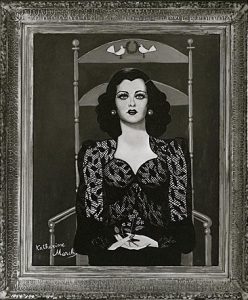Scarlet Street is filled with deception and heartbreak. Set in 1934 during the during the Great Depression, Scarlet Street takes place during a time of great financial troubles and uncertainty. This film’s plot revolves around money, everyone always wanting more but not having credible sources to get it. Upon its December, 1945 release, many censors were concerned with the immoral content and characters portrayed in the film, causing it to be banned in multiple cities across the United States. Yet today it is an unquestioned classic of film noir, where deception and desire haunt its protagonist with ghosts of the past.

Chris Cross and his wife, Adele
Scarlet Street‘s narrative centers around the life of the protagonist, Chris Cross (Edward G. Robinson), a middle-aged cashier and amateur painter. Chris’ wife Adele (Millie Ray) is hostile, shrewd, and has him trapped in a loveless marriage. Chris becomes caught in a love triangle with the young, beautiful actress Kitty March (Joan Bennett) and her fiancé Johnny Prince (Dan Duryea)–as well as the young couple’s desire for money. Not one of the main characters in this film are completely morally sound or just. As Chris falls more and more for Kitty, she continues to deceive and use him, ultimately resulting in everyone receiving undesirable outcomes, far from their original plans and desires.

Kitty March and her fiancé, Johnny Prince
Director Fritz Lang may be better known for films such as Metropolis and M, but his work in both films was crucial to film noir, and he would later direct such other classics of the style as 1953’s The Big Heat. Scarlet Street is similar to his other films in its dark themes and imagery. The story is based on the French novel La Chienne, which translates to The Bitch, by Georges de La Fouchardière, which had previously been adapted to film in 1931 by Jean Renoir, using the same title as the original novel. Scarlet Street was an attempt to follow up on the success of The Woman in the Window, which Lang had also directed, only a year earlier in 1944: both consisted of almost the same cast and crew, and the characters were a lot alike in their roles and portrayals.
Edward G. Robinson, noted more typically for his gangster roles, plays against type as Chris Cross. He is conflicted by love, trapped in a loveless marriage to his wife Adele and his lust and desire for Kitty March. Unfortunately for him, he is unaware that Kitty and her fiancé Johnny are using him and his paintings for money. The film consists of Chris trying to please and win Kitty over, but his desire drives him to do immoral and unjust things to get money for her that he does not have. The film is structured in a chronological manner, so that we are mainly following Chris and his endeavors, but also aware of and following Kitty’s deceit and personal desires. The two characters are both hiding secrets from each other, keeping the other unaware of their actions.

Chris Cross (Edward G. Robinson) is no match for femme fatale Kitty March (Joan Bennett)
Scarlet Street successfully employs techniques similar to other classic film noirs. The mise-en-scene often places Chris in the weaker, powerless position opposed to other characters, especially to Kitty. The low-key lighting creates high contrast in scenes between the light and the dark, often portraying characters deceptively, such as Kitty being shown in a clear, white coat as though she is innocent and angelic when she is sent to Chris in one early scene–even though she is anything but.
Similarly, the chiaroscuro effects make the characters contrast with their background, playing with the light and the dark elements, and helping characters cast those long shadows as they are walking away, a stylistic technique often used in other film noirs. Another interesting parallel this film shares with the film noir Laura is that a painting of the femme fatale used as a haunting reminder to those who knew her.

Painting of Kitty from Scarlet Street
Scarlet Street makes effective use of the kinds of tropes familiar to classic film noir. Kitty is the femme fatale whose schemes threated the protagonist’s life and livelihood; her fate is similar, though not identical, to that of Phyllis Dietrichson’s in Double Indemnity. Scarlet Street also employs the familiar trope of voice-over narration, used in film noirs from Double Indemnity and The Killers to Sunset Boulevard. Here, though, the narration haunts and drives Chris insane, as only he can hear the voices with his guilty thoughts weighing on his conscience.
Fritz Lang’s direction seems intended to make the audience empathize with the main character Chris, to feel his heartbreak, anger, and deception along with him, making his sometimes immoral and unjust actions understandable. The film addresses individuals’ greed, desires, and selfishness, showing how a desire for creature comfort can lead to ruin. Scarlet Street’s protagonist is an ordinary man willing to do anything for the love of a beautiful woman. His desire and lust for the femme fatale ensnares him schemes out of his control. Its themes are emphasized by its mise-en-scene, voice-over, and other film noir techniques, as Chris’s impulsive actions and ultimate misfortune leave him with nothing but ghosts of his past.

Trackbacks/Pingbacks